Venus, Mercury, and Sunset
Today was an interesting day. Following spending 11 hours over the weekend (and 2 more hours debugging today), I wrote some software to properly process astrophotos the way I want them to be processed (the real way  ).
).
Anyway, I took a bunch of photos of Venus and Mercury around 1PM today and I also took some photos of a bright star to characterize the seeing (how much objects were smeared out on the sky by the atmosphere). Unfortunately in Boulder, the seeing is too bad to really see any detailed shape of Mercury, though I can say that I photographed it. Venus came out alright - it's at 93% full right now so nearly a circle, and the seeing was about 2 arcseconds (not great).
I'd read that Venus and Mercury are at a relatively close conjunction now, appearing together in the night sky so I wanted to get some photos of the two at dusk, setting over the mountains. I realized only after I got there around 6:15 that though sunset would be around 6:45, I wouldn't be able to see the two really "pop" until around 8:15.
So I photographed Venus again through the telescope, and this time based on the bright star the seeing was closer to 1.3 arcseconds. Here's how Venus turned out (22 shots median-combined), full-resolution, though since it's about 11 arcsec across there's really no point in displaying it as more than 8-9 pixels across:

Moving on, I was waiting to grab Venus with a wider lens (70 mm instead of 4880 mm). The ONE cloud in the sky was covering it for about 30 minutes. Here's a capture as the cloud finally moved out of the way ... see if you can actually find Venus in it!:

Then, as the sky continued to darken, I finally got what I was aiming for. These shots were taken at 32 mm, f/3.5, 1/6 sec, ISO 100 for the first at 8:03, and 70 mm, f/3.5, 2.5 sec, ISO 400 for the second. Both shots are a combination of 5 images each, median-combined, with the only unfortunate side-effect of removing the stars since they moved in the very short time between shots. Venus is the bright one, Mercury is the less bright one to the right of Venus. I have a third shot but I made the sky a bit too green and don't want to re-process it at the moment.


Anyway, I took a bunch of photos of Venus and Mercury around 1PM today and I also took some photos of a bright star to characterize the seeing (how much objects were smeared out on the sky by the atmosphere). Unfortunately in Boulder, the seeing is too bad to really see any detailed shape of Mercury, though I can say that I photographed it. Venus came out alright - it's at 93% full right now so nearly a circle, and the seeing was about 2 arcseconds (not great).
I'd read that Venus and Mercury are at a relatively close conjunction now, appearing together in the night sky so I wanted to get some photos of the two at dusk, setting over the mountains. I realized only after I got there around 6:15 that though sunset would be around 6:45, I wouldn't be able to see the two really "pop" until around 8:15.
So I photographed Venus again through the telescope, and this time based on the bright star the seeing was closer to 1.3 arcseconds. Here's how Venus turned out (22 shots median-combined), full-resolution, though since it's about 11 arcsec across there's really no point in displaying it as more than 8-9 pixels across:

Moving on, I was waiting to grab Venus with a wider lens (70 mm instead of 4880 mm). The ONE cloud in the sky was covering it for about 30 minutes. Here's a capture as the cloud finally moved out of the way ... see if you can actually find Venus in it!:

Then, as the sky continued to darken, I finally got what I was aiming for. These shots were taken at 32 mm, f/3.5, 1/6 sec, ISO 100 for the first at 8:03, and 70 mm, f/3.5, 2.5 sec, ISO 400 for the second. Both shots are a combination of 5 images each, median-combined, with the only unfortunate side-effect of removing the stars since they moved in the very short time between shots. Venus is the bright one, Mercury is the less bright one to the right of Venus. I have a third shot but I made the sky a bit too green and don't want to re-process it at the moment.


Body: Canon 350D, Canon 7D
Lenses: Canon 35mm f/1.4L, Canon 24-70mm f/2.8L, Canon 70-200mm f/2.8L IS, Canon 18-55mm f/3.5-4.5, Quantaray 70-300mm f/4.5-5.6, Quantaray 600-1000mm f/9.6-16
Flashes: Canon 430EX, Canon 580EX II
0
Comments
www.Dogdotsphotography.com
Visit my (non-photography-related) blog!
Body: Canon 350D, Canon 7D
Lenses: Canon 35mm f/1.4L, Canon 24-70mm f/2.8L, Canon 70-200mm f/2.8L IS, Canon 18-55mm f/3.5-4.5, Quantaray 70-300mm f/4.5-5.6, Quantaray 600-1000mm f/9.6-16
Flashes: Canon 430EX, Canon 580EX II
I like the cropped in versions better. Your subject sticks out much more
www.Dogdotsphotography.com